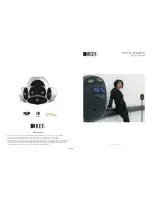
– CIS961 and CIS991
1. SAFETY INSTRUCTIONS
1. Read these instructions.
2. Keep these instructions.
3. Heed all warnings.
4. Follow all instructions.
5. Do not use this apparatus near water.
6. Clean only with a dry cloth.
7. Do not block any ventilation openings. Install in accordance with the
manufacturer’s instructions.
8. Do not install near any heat sources such as radiators, heat registers,
stoves, or other apparatus (including amplifiers) that produce heat.
9. Only use attachments/accessories specified by the manufacturer.
10. Refer all servicing to qualified service personnel. Servicing is required
when the apparatus has been damaged in any way, such as liquid has
been spilled or objects have fallen into the apparatus, the apparatus has
been exposed to rain or moisture, does not operate normally, or has been
dropped.
11. The entire sound system must be designed in compliance with the current
standards and laws regarding electrical systems.
12. When installing and using this apparatus, keep in mind the technical
specifications indicated in the dedicated section of the manual.
13. Exposure to high sound levels can cause permanent hearing loss. The
sound pressure level which leads to hearing loss varies considerably
from one person to another, and depends on the duration of exposure.
The U.S. Government’s Occupational Safety and Health Administration
(OSHA) has established the maximum sound pressure levels that can be
with stood without causing damage, which are shown in the table below.
According to the OSHA regulations, any exposure over the maximum
limits indicated in the table can reduce the hearing capacity of a person.
To prevent potentially dangerous exposure to high sound pressure levels,
anyone subjected to such levels must use suitable protection. When
a EAW Commercial product capable of producing high sound levels is
being used, it is therefore necessary to wear ear plugs or protective
earphones when the limits shown in the table are exceeded. Consult the
specifications provided in the instruction manual to know the maximum
sound pressure (SPL) the loudspeaker is capable of producing.
14. Rigging Precautions: When mounting or suspending EAW Commercial
loudspeaker enclosures, it is essential that load ratings, rigging
techniques, and special safety considerations be appropriate for the
installation. Use only the mounting/rigging points on the loudspeaker
enclosure intended for this purpose. The user must determine the load
requirements, dynamic loading, and any other contributing factors
affecting the loudspeaker installation. The user must determine the
proper design factor for specific applications and the required load rating
of the connection to structure. Comply with all applicable federal, state,
and local regulations.
EAW Commercial strongly recommends the following rigging system
practices:
• Documentation: Thoroughly document the mounting/rigging design
with detailed drawings and parts lists.
• Analysis: Have a licensed structural engineer or other qualified
professional review and approve the mounting/rigging design before its
implementation.
• Installation: Use personnel experienced and qualified for mounting/
rigging loudspeakers in accordance with and in compliance with all
federal, state and local regulations.
DANGER: Loudspeakers should be mounted or suspended only
by persons with knowledge of the proper hardware and rigging
techniques. Failure to follow these precautions may result in damage
to the equipment, personal injury, or death.
WARNING!
This equipment has been designed
to be installed by qualified professionals only!
There are many factors to be considered when
installing professional sound reinforcement systems,
including mechanical and electrical considerations, as well
as acoustic coverage and performance. EAW Commercial
strongly recommends that this equipment be installed only by a
professional sound installer or contractor.
r
e
p
n
o
i
t
a
r
u
D
)
s
r
u
o
h
(
y
a
d
l
e
v
e
l
d
n
u
o
S
)
A
B
d
(
e
l
p
m
a
x
e
l
a
c
i
p
y
T
8
0
9
b
u
l
c
ll
a
m
s
a
n
i
o
u
D
6
2
9
4
5
9
n
i
a
r
t
y
a
w
b
u
S
3
7
9
2
0
0
1
c
i
s
u
m
l
a
c
i
s
s
a
l
c
d
u
o
l
y
r
e
V
5
.
1
2
0
1
1
5
0
1
t
e
e
f
0
5
t
a
e
v
i
t
o
m
o
c
o
L
5
.
0
0
1
1
s
s
e
l
r
o
5
2
.
0
5
1
1
t
r
e
c
n
o
c
k
c
o
r
a
t
a
s
t
r
a
p
t
s
e
d
u
o
L
The exclamation point within an equilateral triangle is
intended to alert the user of the presence of important
operating and maintenance (servicing) instructions in
the literature accompanying the apparatus.
Contents
1. SAFETY INSTRUCTIONS ...................................................
. INTRODUCTION ..................................................................3
3. FRONT PANEL FEATURES .................................................4
4. REAR PANEL FEATURES ....................................................5
5. INSTALLING THE LOUDSPEAKER ....................................6
6. SPECIFICATIONS ..............................................................10
7. OPTIONAL KITS ................................................................16
8. SERVICE INFORMATION .................................................19
9. EAW COMMERCIAL WARRANTY ..................................19
Part No. 0023640 Rev. A 03/08
© 2008 LOUD Technologies Inc. All Rights Reserved.



































